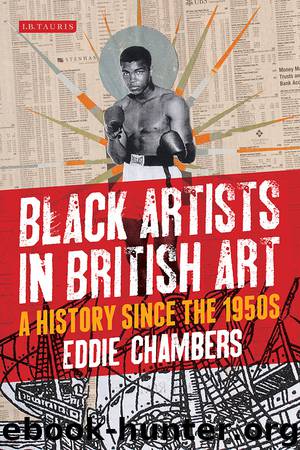Black Artists in British Art by Eddie Chambers

Author:Eddie Chambers
Language: eng
Format: epub
Publisher: I.B.Tauris
Published: 2014-04-17T04:00:00+00:00
CHAPTER NINE
The Emergence of Black Women Artists:
Arguments and Opinions
During the period of the early to mid 1980s the distinct, specific entity of the ‘Black woman artist’ emerged alongside the more general (and non-gender-specific) presence of the ‘Black’ artist. By 1986, the impact and importance of this development was widely acknowledged, resulting, temporarily at least, in the significant raising of the profile of Black women artists such as Sonia Boyce and Maud Sulter, by sections of the art establishment. In 1988 Sonia Boyce achieved the distinction of being the first British-born Black artist to have had a solo exhibition at the Whitechapel Art Gallery1 and Maud Sulter was awarded the Momart Fellowship at Tate Gallery, Liverpool in 1990–1991. In an overview of Black visual arts practice in Britain, from the 1950s through to the mid 1980s, Errol Lloyd noted that ‘Women are now stepping out, and for the first time in Britain black women artists are exhibiting together, as well as exploring issues of common concern and creativity together, without the sometimes stifling intervention of men.’2
This emergence was centred on three particular exhibitions organised and curated by Lubaina Himid which signalled the newly conspicuous presence of Black women artists. These were the first exhibitions of Black women artists in Britain to be labeled as such. The first of these exhibitions was Five Black Women Artists,3 which took place at the Africa Centre, a venue that had increasingly come to be used by a newer, younger generation of practitioners whose links with the African continent most frequently existed via the diaspora. The exhibition featured Sonia Boyce, Lubaina Himid, Claudette Johnson, Houria Niati, and Veronica Ryan. Whilst Boyce and Johnson were British-born, and Himid, Niati and Ryan were born in Zanzibar, Algeria and Montserrat respectively, these artists typified the profile of new Black artists in Britain. They were educated in Britain, art school-trained, and adept at using the languages and devices of modern and contemporary art, to make the work they wanted to make.
Two other vitally important factors in the practices of these artists were their critical approaches to art history and the extent to which they were referencing ongoing debates about the specificities of the identities and struggles of Black women. During the course of the late twentieth/early twenty-first century, a new generation of Black artists made work that critiqued and interrogated dominant notions of art history. These artists, having received BA and, in some instances, MA degrees from the country’s art schools, were well placed to appreciate the extent to which dominant notions of the Western art historical canon excluded, as a matter of course, artists such as themselves. These Black artists were keenly aware of the ways in which art history had failed them, and were determined that this willful failure would not go unremarked or unchallenged. Consequently, their work frequently resonated with references to the manifestation, consequences, and implications of this exclusion. But this was not simply a strategy of critique and critical engagement. Artists such as Himid took art history to task, partly as a way of inserting themselves into its narrative.
Download
This site does not store any files on its server. We only index and link to content provided by other sites. Please contact the content providers to delete copyright contents if any and email us, we'll remove relevant links or contents immediately.
The Art of Boudoir Photography: How to Create Stunning Photographs of Women by Christa Meola(18473)
Red Sparrow by Jason Matthews(5322)
Harry Potter 02 & The Chamber Of Secrets (Illustrated) by J.K. Rowling(3599)
In a Sunburned Country by Bill Bryson(3451)
Drawing Cutting Edge Anatomy by Christopher Hart(3420)
Figure Drawing for Artists by Steve Huston(3347)
Harry Potter and the Prisoner of Azkaban (Book 3) by J. K. Rowling(3250)
The Daily Stoic by Holiday Ryan & Hanselman Stephen(3194)
Japanese Design by Patricia J. Graham(3080)
The Roots of Romanticism (Second Edition) by Berlin Isaiah Hardy Henry Gray John(2852)
Make Comics Like the Pros by Greg Pak(2820)
Stacked Decks by The Rotenberg Collection(2773)
Draw-A-Saurus by James Silvani(2612)
Harry Potter and the Deathly Hallows (7) by J.K. Rowling(2609)
Tattoo Art by Doralba Picerno(2565)
On Photography by Susan Sontag(2541)
Churchill by Paul Johnson(2468)
The Daily Stoic by Ryan Holiday & Stephen Hanselman(2424)
Foreign Devils on the Silk Road: The Search for the Lost Treasures of Central Asia by Peter Hopkirk(2407)
